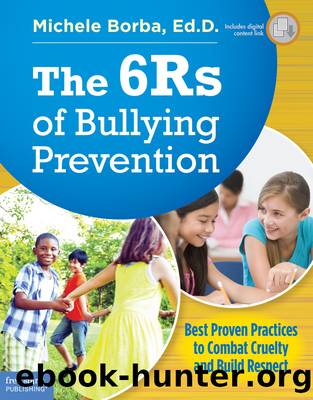The 6Rs of Bullying Prevention by Michele Borba

Author:Michele Borba
Language: eng
Format: epub
ISBN: 9781631981043
Publisher: Free Spirit Publishing
Published: 2016-10-11T00:00:00+00:00
Meet with your staff and ask these questions: Which students are more likely to come to us, and which ones are we overlooking? What can we do to help special needs, ESL, and introverted kids feel they can report concerns to us? If we were in our studentsâ places, what would we need to feel safe enough to report bullying?
Make your word good. The easiest way to let kids know youâre taking their concerns seriously is to act on their reports. The word will spread among kids as to which staff members can and cannot be counted on to follow through. Emphasize that threats need to be reported and will be taken seriously. Repeat this announcement school-wide and/or in each classroom so that all students understand.
Convey your message as a unified team. Many schools hold an assembly (sometimes with police involvement) to convey the seriousness of reporting threats or bullying. Other schools have a building administrator meet individually with each homeroom class to explain reporting options. The key is to stress to students that all threats will be reviewed. An administrator of a private school in Taipei held a school-wide assembly and asked the student council to urge the student body to report bullying incidents and threats. The staff agreed that the students convinced far more peers to report than adults could have done.
Hold âFive-Minute Urgent Talks.â One of the most powerful strategies Iâve seen was in a middle school where the student council asked the principal if they could go to each homeroom and give a âfive-minute urgent talkâ (the studentsâ words) to encourage their peers to report bullying incidents. They were able to mobilize the majority of students to do so.
Make reporting a rule. Some schools institute a rule that itâs against school policy (for all stakeholders except the targeted child) not to report bullying or threats. Check your anti-bullying policy to verify that the wording is there. After students understand that rule, they are more likely to report bullying incidents.
Initiate a student poster campaign. A team of middle school students in Arkansas asked their principal if they could start a poster campaign to encourage peers to report bullying. Dozens of colorful, student-made posters lined the hallways with captions such as âItâs Okay to Tell,â âWant to Stop Bullying? Report it!,â and âTuluka Kids Stop Bullying by Reporting.â
STUDENTS TELLING STUDENTS
Research shows that students often are more comfortable telling peers about bullying than telling adults.8 This reporting method is not utilized enough on school campuses. The majority of peers are also sympathetic toward kids who are frequently victimized by bullying, so mobilize them as âpeer helpers.â Here are suggestions for having students report to other students.
Report bullying as a duo. Many targeted kids who are uncomfortable reporting bullying incidents to an adult alone will do so with a peer. Another student can accompany the targeted child or bystander to report the bullying incident and serve as a supportive companion. Teach students to ask a child who has been targeted: âWould you like me to go with you to report this to a teacher?â
Use peer mentors.
Download
This site does not store any files on its server. We only index and link to content provided by other sites. Please contact the content providers to delete copyright contents if any and email us, we'll remove relevant links or contents immediately.
The Art of Coaching Workbook by Elena Aguilar(48057)
Trainspotting by Irvine Welsh(20052)
Twilight of the Idols With the Antichrist and Ecce Homo by Friedrich Nietzsche(17705)
Fangirl by Rainbow Rowell(7832)
Periodization Training for Sports by Tudor Bompa(7327)
Change Your Questions, Change Your Life by Marilee Adams(6639)
This Is How You Lose Her by Junot Diaz(5767)
Grit by Angela Duckworth(4734)
Red Sparrow by Jason Matthews(4661)
Asking the Right Questions: A Guide to Critical Thinking by M. Neil Browne & Stuart M. Keeley(4573)
Paper Towns by Green John(4168)
Room 212 by Kate Stewart(4102)
Ken Follett - World without end by Ken Follett(3972)
The Sports Rules Book by Human Kinetics(3585)
Housekeeping by Marilynne Robinson(3401)
The Motorcycle Diaries by Ernesto Che Guevara(3332)
Introduction to Kinesiology by Shirl J. Hoffman(3299)
Exercise Technique Manual for Resistance Training by National Strength & Conditioning Association(3290)
Double Down (Diary of a Wimpy Kid Book 11) by Jeff Kinney(3272)
